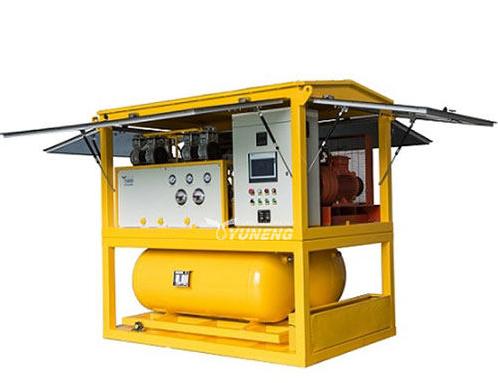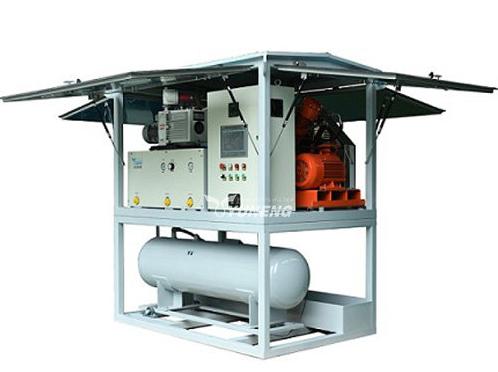The Crucial Role of SF6 Gas Recovery in the Modern Electrical Grid
The modern electrical grid, the backbone of our technologically dependent society, relies on a delicate balance between efficient power transmission and environmental sustainability. This intricate network is heavily influenced by sulfur hexafluoride (SF6), an exceptional insulating and arc-quenching gas employed in high-voltage switchgear. While SF6 enables robust electricity transmission, its potent greenhouse gas properties pose a significant environmental challenge. Thankfully, the SF6 recovery system emerges as a critical solution, offering a multi-faceted approach to mitigating climate impact and ensuring responsible resource management within the electrical grid.

The Environmental Dilemma of SF6: A Balancing Act between Efficiency and Sustainability
Exceptional Insulator and Arc-Quencher
Sulfur hexafluoride (SF6) has revolutionized high-voltage power transmission due to its exceptional insulating properties. In contrast to air, SF6 exhibits significantly higher dielectric strength, meaning it requires a much higher voltage to spark an arc across a given distance. This characteristic allows for compact switchgear designs with smaller equipment footprints and reduced insulation gaps compared to air-insulated systems.
Furthermore, SF6 excels at arc suppression. During normal operation, electrical contacts within switchgear open and close, generating momentary arcs. SF6’s high molecular weight and electronegativity effectively capture and de-energize these arcs, preventing catastrophic equipment damage and ensuring reliable power transmission.
The Hidden Danger: Potent Greenhouse Gas
However, beneath its technical prowess lies a hidden environmental threat. SF6 is a potent greenhouse gas with a global warming potential (GWP) 22,800 times higher than carbon dioxide (CO2) on a 100-year timescale. This means that a single kilogram of leaked SF6 has the same warming effect as over 22 tons of CO2.
This stark reality puts considerable pressure on the electrical grid industry. Leaks and improper handling of SF6 equipment can contribute significantly to its atmospheric presence, exacerbating climate change and undermining efforts towards greenhouse gas reduction.
The urgency of Addressing SF6 Emissions
Addressing SF6 emissions is critical for mitigating climate change and transitioning towards a sustainable energy future. Implementing robust leak detection and prevention strategies, adopting responsible gas handling practices, and embracing SF6 recovery technologies are all crucial steps in minimizing its environmental impact.
The urgency of action is undeniable. SF6 emissions have been steadily increasing in recent years, posing a growing threat to global climate goals. Delaying the implementation of effective mitigation measures will only amplify the challenge and prolong the environmental consequences.
The Benefits of Recovering SF6 Gas
1. Curbing Greenhouse Gas Emissions
The most compelling argument for SF6 recovery lies in its potent impact on mitigating climate change. SF6 recovery plays a critical role in sequestering this high-GWP gas, preventing its release into the atmosphere. This translates to a direct reduction in greenhouse gas emissions, contributing significantly to global climate action goals outlined in the Kyoto Protocol and Paris Agreement.
The environmental benefits are demonstrably substantial. Capturing just a fraction, 1% of annual SF6 leaks and discharges, can yield a dramatic impact equivalent to removing over 1 million cars from the road in terms of annual CO2 emissions. This comparison underscores the sheer magnitude of the environmental dividend associated with SF6 recovery.
2. Resource Conservation and Extended Utilization
Beyond the immediate climate impact, SF6 recovery promotes resource conservation, a crucial aspect of sustainable grid management. SF6 is a limited resource, extracted from specific mineral deposits. Excessive reliance on virgin SF6 depletes these reserves, leading to increased extraction costs and potential environmental impacts associated with mining activities.
SF6 recovery offers a compelling solution by extending the lifespan of this valuable gas. By capturing and purifying used SF6, it can be reintroduced into the grid, reducing the need for virgin gas extraction and minimizing the overall environmental footprint of the electrical grid. This circular economy approach optimizes resource utilization and ensures long-term sustainability.
3. Substantial Cost Savings
While environmental imperatives drive the ethical responsibility for SF6 recovery, the economic benefits are equally compelling. Recovering and refilling SF6 is demonstrably more cost-effective than purchasing new gas. The price of reclaimed SF6 is a fraction of the cost of virgin gas, leading to significant savings for utilities and grid operators. These cost reductions can be reinvested in grid modernization, maintenance, or renewable energy initiatives, further enhancing the overall efficiency and sustainability of the system.

Diverse Solutions for SF6 Reclamation
The quest for efficient and reliable SF6 recovery has woven a multifaceted tapestry of diverse technologies, each offering distinct advantages for gas purification and reuse. This intricate technology caters to varied needs within the electrical grid, optimizing resource utilization and minimizing environmental impact.
- Membrane Separation: Precision Filtration for High Purity
At the heart of this tapestry lies membrane separation, a sophisticated filtration process utilizing semi-permeable membranes with selective permeation characteristics. These membranes allow SF6 molecules to pass through due to their specific size and properties, while effectively barring other impurities like contaminants and moisture. This method excels in its ability to deliver high purity recovered SF6, often exceeding industry standards, making it ideal for applications requiring stringent quality control, such as refilling high-voltage switchgear. Additionally, membrane separation boasts high efficiency and throughput, making it a cost-effective and scalable solution for large-scale recovery operations.
- Cryogenic Condensation: Absolute Purity through Controlled Freezing
Where absolute purity reigns supreme, cryogenic condensation emerges as the technology of choice. This method harnesses the principles of cryogenics, employing extremely low temperatures to achieve gas liquefaction. As the contaminated SF6 gas mixture is subjected to progressively colder temperatures, its various components condense and solidify at different rates. This allows for the precise separation of SF6 from other impurities, resulting in recovered gas of unparalleled purity. While comparatively energy-intensive, cryogenic condensation caters to specific high-voltage equipment needs demanding the highest purity standards, such as gas-insulated substations.
- Adsorption Technology: Versatility and Continuous Recycling
Offering a versatile and customizable approach is adsorption technology. This method leverages the selective binding properties of specific sorbent materials to capture SF6 molecules from contaminated gas streams. Tailored sorbents are chosen based on their high affinity for SF6, effectively attracting and binding the gas molecules onto their surface. Subsequent regeneration cycles desorb the captured SF6, releasing it for reuse in the grid. This cyclical process allows for continuous gas recycling, making adsorption technology a valuable tool for managing SF6 inventories within closed-loop systems or facilities with frequent SF6 handling requirements.
Yuneng: Spearheading Sustainable SF6 Recovery with Advanced Technology
Yuneng stands at the forefront of SF6 recovery solution providers, resolutely committed to forging a cleaner and more sustainable future for the electrical grid. Their flagship SF6 Gas Recovery Plant epitomizes cutting-edge technology, equipped with:
- Combination of High-pressure liquefaction method and Adsorption Technology. At the heart of the system lies Yuneng’s exclusive technology, featuring a meticulously engineered combination of High-pressure liquefaction method and Adsorption Technology tailored for exceptional SF6 separation. It can effectively filter out impurities while maximizing the recovery of SF6 molecules. This meticulous design consistently surpasses industry standards, exceeding purity specifications for even the most demanding applications.
- Unrivaled Efficiency: Yuneng’s systems have been meticulously optimized to deliver unparalleled recovery rates, exceeding an impressive 99.5%. This minimization of gas losses translates to maximized resource utilization, significantly reducing the demand for virgin SF6 extraction and its associated environmental footprint.
- Stringent Environmental Compliance: Recognizing the environmental imperative of responsible gas handling, Yuneng prioritizes the highest safety standards and unwavering adherence to international regulations. Comprehensive protocols govern every aspect of the recovery process, from initial gas handling to final product storage, ensuring the environment and personnel are safeguarded.
- User-Friendliness and Minimal Downtime: Recognizing the operational needs of grid operators, Yuneng prioritizes user-friendly systems requiring minimal maintenance. Intuitive interfaces and streamlined workflows facilitate ease of operation, while robust design elements ensure exceptional reliability and minimize downtime. This translates to reduced operational costs and maximized uptime for uninterrupted grid operations.

Conclusion
SF6 gas recovery is not merely a technical solution; it represents a paradigm shift towards a more sustainable and responsible approach to managing the electrical grid. By embracing innovative recovery technologies and partnering with responsible providers like Yuneng, we can unlock the full potential of SF6 while mitigating its environmental impact. Recovering this valuable resource not only safeguards our planet but also paves the way for a future where reliable and efficient electricity transmission coexists with environmental sustainability. The responsibility lies with us, the stakeholders in this interconnected world, to prioritize responsible resource management and embrace technologies that empower us to navigate the delicate balance between progress and environmental stewardship.
